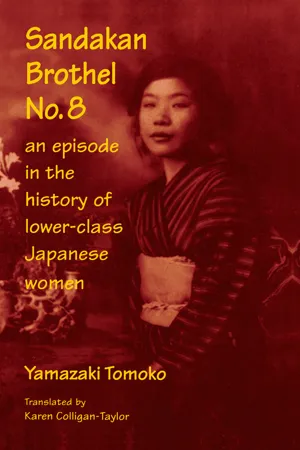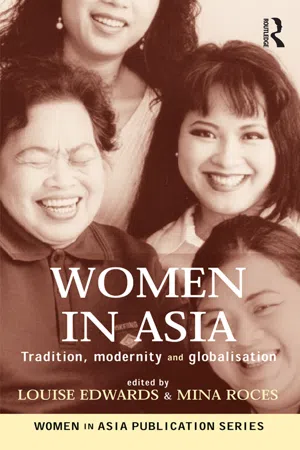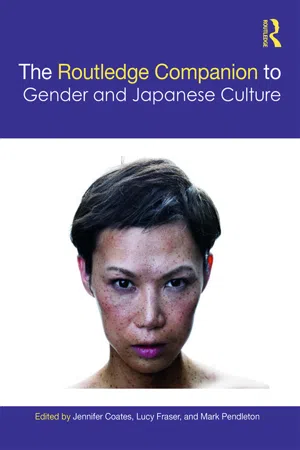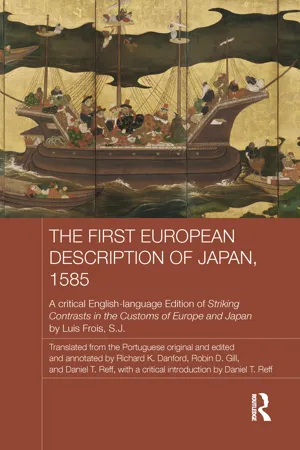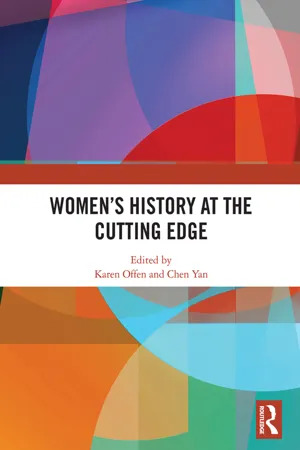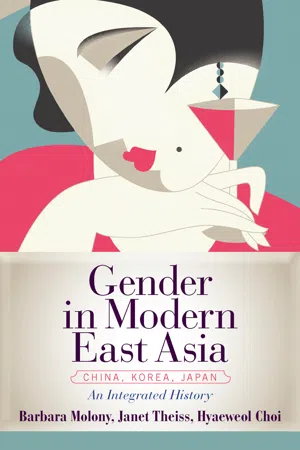History
Women in Early Japan
Women in early Japan held important roles in both the household and religious practices. They were often responsible for managing the household and raising children, and some women even held positions of power as priestesses. While they were generally subordinate to men in the social hierarchy, women in early Japan had significant influence and were valued for their contributions to family and community life.
Written by Perlego with AI-assistance
Related key terms
8 Key excerpts on "Women in Early Japan"
- eBook - ePub
Sandakan Brothel No.8
Journey into the History of Lower-class Japanese Women
- Tomoko Yamazaki, Karen F. Colligan-Taylor(Authors)
- 2015(Publication Date)
- Routledge(Publisher)
karayuki-san , a faded memory from the distant past, when there are so many other women’s issues I might confront. This is a difficult question to answer, but, frankly speaking, it is because the women of the villages of Amakusa and Shimabara who were once sold into overseas prostitution are the embodiment of the suffering experienced by all Japanese women who have long been oppressed under the dual yoke of class and gender. In other words, these women represent the “starting point” or “quintessence” of women’s existence in Japan.I am getting ahead of myself, but it should be noted that until now the majority of all Japanese history texts, from the Nihon shoki of the Nara period (710–784) to contemporary collections, have been written by the dominant male sex. Since the introduction of Marxist ideology and methodology at the beginning of the Showa period (1926–1988), attempts have been made to write history from the perspective of laborers and farmers, but because these histories also adhere firmly to the male standpoint, they do not differ from earlier works. “Women’s history” made its debut only after Japanese imperialism collapsed in 1945, upon Japan’s defeat in World War II, and women were guaranteed political and social rights. In my opinion, however, these historical treatises were, with few exceptions, histories of an elite segment of women and nothing else.For example, most of these women’s histories follow a certain formula: they open the modern era with an account of Tsuda Umeko’s study exchange to America in 1872, following this with the activities of Kishida Soen and Fukuda Eiko, proponents of the Liberal Rights Movement. Then they mention the work of Yosano Akiko, who spoke loudly through her poems of the awakening of self-consciousness at the level of the senses, and go on to discuss Seito , the publication of those such as Hiratsuka Raicho who were active in Japan’s Bluestocking movement.1 - eBook - ePub
Women in Asia
Tradition, modernity and globalisation
- Louise Edwards, Mina Roces(Authors)
- 2020(Publication Date)
- Routledge(Publisher)
This is not just a rhetorical question, and the answer is not a simple ‘yes’ or ‘no’. In this essay I want to convey the complexity of an answer to the question. On the one hand, there are commonalities among all or at least most Japanese women—factors that affect all women because they are women. On the other hand, Japanese women are not all alike and their experiences have been diverse due to differences in class, generation or age, geography (regional as well as urban vs rural), ethnicity and education. By looking at four areas of activity—the home, the workplace, the public arena and the world of popular culture—we will see that the range of options for women has widened during the past three decades. However, we will also see that the patriarchal underpinnings of social, economic and political institutions and practices remain firmly entrenched to perpetuate the sexual division of labour. These institutions and practices, both informally and formally, act as powerful influences on women’s choices.At the same time, while still generally favouring men, the messages that these institutions and practices send to women are not always consistent or uniform. These contradictions open up a space in which women are able to try to accommodate their individual needs and desires to the state’s and society’s expectations. The state, for example, promotes an image of women that is oriented contradictorily to both production and reproduction while the media encourages women to be consumers. Women may respond in different ways to these varied and sometimes contradictory conceptions of their proper role. However, I have said ‘accommodate’ to indicate that radical feminism has not been widely accepted by Japanese women (not that it has in any society) and to suggest that the ideology placing women primarily in nurturing roles has in many if not most cases been internalised.The home: women’s domain?
Some scholars, such as Sumiko Iwao (1993), as well as most Japanese men and the media, represent the home as a sphere where Japanese women enjoy dominant status and power. In most Japanese families the husband hands over his pay packet to his wife who then gives him ‘an allowance’ for pocket money and generally takes charge of the day-today management of the household’s activities and expenses. She is also fully responsible for the rearing and education of the children. The images of ‘the professional housewife’ and ‘education mama’ which have emerged in the post-World War Two period indicate the complete devotion and skill required for success in these endeavours as well as the high social value placed on women’s role as wives and mothers. - Jennifer Coates, Lucy Fraser, Mark Pendleton, Jennifer Coates, Lucy Fraser, Pendleton Mark(Authors)
- 2019(Publication Date)
- Routledge(Publisher)
agency, which we deploy as if they were universally applicable rather than as contested categories that have been the subject of impassioned debates amongst serious scholars. By ignoring these debates, we fail to do justice to the very cause that we claim to have espoused. There is also a danger here that in our desire to speak on behalf our “sisters,” we sometimes unwittingly reproduce the imperialising gestures of first-world feminism (Talpade Mohanty 1984, 333–358).To conclude, gender difference was undoubtedly central to the hierarchical order of the world of pre-modern Japan, and women within it were without question positioned as inferior to men. However, difference was not constituted through “man” and “woman” understood as fixed and stable categories, defined through their bodies. Gender was inextricably tied to the performative aspects of the body. The performance of gender was by no means uniform, and it produced a multiplicity of ways of being “woman” or “man.” The instability of the body and its potential for transformation made gender a materialization that was never fixed or complete: it was in the nature of a verb rather than a noun.Further readings
Mostow, J., Bryson, N. and Graybill, M. (eds) (2003) Gender and Power in the Japanese Visual Field, Honolulu: University of Hawai’i Press.Pflugfelder, G. (1999) Cartographies of Desire: Male-Male Sexuality in Japanese Discourse 1600–1950, Berkeley: University of California Press.Yoda, T. (2004) Gender and National Literature: Heian Texts in the Construction of Japanese Modernity, Durham, NC: Duke University Press.Related chapters
- 13 Changing Folk Cultures of Pregnancy and Childbirth
- 28 Gender in Japanese Literature and Literary Studies
- 33 Gender, Media, and Misogyny in Japan
References
Ames, R. (1993) “The Meaning of the Body in Classical Chinese Philosophy,” in T. P. Kasulis et al. (eds) Self as Body in Asian Theory and Practice- eBook - ePub
The First European Description of Japan, 1585
A Critical English-Language Edition of Striking Contrasts in the Customs of Europe and Japan by Luis Frois, S.J.
- Luis Frois SJ, Daniel T. Reff, Richard Danford, Robin Gill(Authors)
- 2014(Publication Date)
- Routledge(Publisher)
2 Women, their persons and customs1. In Europe a young woman’s supreme honor and treasure is her chastity and the inviolate cloister of her purity; women in Japan pay no mind to virginal purity nor does a loss of virginity deprive them of honor or matrimony.During the sixteenth century European women continued to struggle as they had for centuries with societal norms that cast them in a subordinate role relative to men. Although women did “men’s work” (e.g. butcher, fisher, merchant, renter, moneylender, sovereign), and did it well1 this reality was systematically obscured and women by and large were denied access to education, opportunity, and power. The situation might have been better for Japanese women; it is hard to say, given that literature and the historical record are ambiguous. While Shinto’s most beloved kami was a woman–(the Sun Goddess, Amaterasu–) and the Pure Land schools of Buddhism proclaimed women capable of salvation, Shinto, Buddhism, and Confucianism more frequently spoke of women as “imperfect” (respectively: sources of pollution; spiritually “obstructed;” a potential threat to familial harmony) and best suited to supporting roles.As this first distich and the twenty-seven that follow suggest, Europeans treated women’s bodies as a fetish. This fetishization is often reflected in Frois’ surprise that Japanese women’s clothing revealed as much as it did. Beginning with distich twenty-nine, Frois’ focus is more on behavior and rights and responsibilities. Again, the tone of the distichs is one of surprise that Japanese women enjoyed inheritance of property, relative freedom of movement, etc.While Frois’ distichs in this chapter necessarily provide a partial picture of the lives of women in Japan as well as Europe, they tend to support recent scholarship that has emphasized the significant changes in gender roles in Japan, particularly since the Meiji Period (1868–1912). The Japan that Frois experienced was a nation of mostly farm households and small businesses (i.e., artisans and merchants) where men and women worked together at home, sharing many rights and responsibilities, including nurturing and child-rearing. Complicating matters, however, was the rise to power of the samurai during the late medieval and warring states period (1467–1568), which created a privileged male culture centered on warfare. The empowerment of the samurai class and the subsequent emulation of their norms by lesser classes undermined the relative gender equality that Frois mentions or alludes to. Gender inequality was further exacerbated during the second half of the nineteenth century when the Japanese state whole-heartedly pursued industrialization, relegating women to a cult of domesticity while promoting male education and employment away from home.2 - eBook - ePub
- Laura Dales(Author)
- 2009(Publication Date)
- Routledge(Publisher)
sengyō shufu—sararīman) model and the family model. In this context, models should not be interpreted as representing a universal pattern, nor do they reveal the subtle variations and adaptations that are made by those encompassed. It is precisely this that makes them useful in an overview of this nature yet also limits their applicability to a detailed analysis of women’s issues. While particular models (and ideals) may be promulgated and propagated by media, folklore, state policy and legislation, the adoption, adaptation and rejection of models occurs on a daily basis in the lived experiences of individuals. The model captures only one aspect or one point in time of that experience, using that information as a centre point for extrapolation or speculation on a broader scale. However, the model cannot reveal the ways that individuals transgress, challenge or reform ideals, nor can it reveal the individualistic ways that this occurs; hence it is useful in broad discussions and has limitations as a lens for micro studies. It is with these limitations in mind that I proceed.Women in Imperial Japan—family and feminism
Women’s lives are nothing but a series of services, first to parents when young, then to husbands and parents- in-law when married, and when children come, they are busy caring for them and supervising the food and kitchen work.(Fukuzawa, cited in Fujiwara 1988: 19)These words were written by liberal social critic and proponent of Western thought Fukuzawa Yukichi, and they illustrate the status of the majority of Japanese women towards the end of the nineteenth century. Influenced by the work of John Stuart Mill and inspired by the work of Japanese female activists, Fukuzawa’s critique of female subordination in society illustrates two key points: that feminist thought had taken root in Japan long before the women’s lib movement bloomed and that advocates of gender equality could be found even within the depths of the Meiji revival of patrilineal and patriarchal customs (Fujiwara 1988: viii).In Imperial Japan (the period spanning 1890–1945) the family was the crucible of feminine duty. The responsibilities of the daughterly role gave way to those of the wife, daughter- in-law and mother. The Meiji (1868–1912) abolition of the distinct class system and the reduced influence of the aristocratic (samurai) code meant that women who had previously enjoyed relative flexibility of status were now bound to the Confucian ‘three obediences’ to which the above quote refers (Iwao 1993: 5). The catchphrase ‘ryōsai kenbo’ (good wife, wise mother) exemplifies the ideal of femininity prescribed by the Meiji state, and the promotion of women’s education reflected this emphasis on women as ‘intelligent incubators’.1 - eBook - ePub
- Karen Offen, Chen Yan, Karen Offen, Chen Yan(Authors)
- 2020(Publication Date)
- Routledge(Publisher)
In this essay, I will first explain briefly how women’s history developed in Japan, referencing early research on the topic. Then, I will discuss the arguments about the shift from women’s history to gender history, the necessity of which has been loudly insisted on since the middle of the 1990s. Third, I will explain the organizational development as observed in the establishment of the Gender History Association of Japan in which I myself participated and served as the second president from 2008 to 2010. The fourth point I wish to consider is the realignment of the Science Council of Japan to include more women and the resultant efforts on the part of practitioners of women’s/gender history to change history textbooks for high school students to accommodate gendered viewpoints. Finally, I will discuss the task of gendering contact zones, colonialism and empire with particular attention to the issue of ‘comfort women’.A Brief Historiography of Women's History in Japan
According to Hiroko Nagano, a historian of the Edo period teaching at Chuo University, Tokyo, the development of women’s history in Japan can be divided roughly into three periods.2 The first is from 1930s to 1970s. The period begins with Itsue Takamure’s (legendary independent historian and poet, 1894–1964) energetic work on matriarchy in ancient Japan, which was first published in 1938.3 After World War II, as women gained the right to vote, several women’s history books appeared one after another. The most popular among them was Japanese Women’s History by Kiyoshi Inoue (1913– 2001),4 a professor emeritus at the University of Kyoto, who wrote the history from the Marxist perspective, the most influential meta-narrative among Japanese historians in those days. In the 1970s, interest in women’s everyday life rose and many local study groups emerged to probe for ordinary women’s past and their experiences. Representing this trend, Nobuhiko Murakami (1909–1983), an independent writer, published four volumes of Japanese Women’s History in the Meiji Period between 1969 and 1972, in which he emphasized the importance of ordinary women and their everyday experiences in presenting women’s history.5 Murakami’s work intended to criticize Inoue’s Marxist narrative for its monolithic description of women’s history leading toward emancipation, its narrow focus on a few emancipatory leaders such as Eiko Kageyama,and its naïve grasp of sex discrimination as part of class oppression,expecting that the former would dissolve with the victory of the laboring class over the capitalists. Murakami’s criticism provoked heated discussion among historians; these debates are recorded in a book, Documents of Contentions Concerning Women’s History edited by Yukiko Kozai.6 Tamae Mizuta, a historian of social thought, participated in this debate and pointed out that discrimination and oppression based on sex are different from those based on class, a claim that is now taken for granted.7 - eBook - ePub
- Joyce C Lebra(Author)
- 2019(Publication Date)
- Routledge(Publisher)
Chapter 11Women in the Political SystemAlthough men have traditionally dominated the political system in Japan, frequently women have held important political positions. Prior to the eighth century, women could succeed to the throne and rule as empresses. Chinese thought and custom influenced the adoption of the Taihō Code which undermined women’s position in Japan. Women’s basic equality was replaced by the Chinese concept of women’s inferiority and heavenly ordained subjugation to men. These changes were slow in penetrating the Japanese social and political systems. In the Kamakura period (1185–1333), women could no longer succeed to the throne, but they were still acknowledged as legal persons. They retained their property rights and could avail themselves of divorce, although their access to power was not as great as men’s. During this period an exceptional woman, Masako Hōjō, took power in the wake of the death of her husband, the Shogun Yoritomo. She kept the loyalty of her late husband’s retainers and manipulated Court relationships in her efforts to consolidate her position and power. With the help of her father, she made her son the Shogun and ruled as his regent. Later she had him murdered when he attempted to rule himself and exiled her father when he opposed her. Masako Hōjō later ruled through her brother as the regent of her late husband’s two-year-old great grand nephew, the Shogun. Ruling through sons, brothers and other relatives was not required because of her sex, but it was rather a traditional means of exercising political power.Political confusion and internal warfare characterized the period between 1336 and 1573, when the central government lost its control over the local leaders. Military power became a prerequisite for political power. The social code of the newly dominant military class assigned women to subordinate roles within the family and limited their access to political roles. Without direct access to military power, women resorted to personal influence on the men in powerful positions. Marriage was a political device for the powerful families to create alliances, often using the women as hostages. Married women provided access to power through their husbands for their male relatives. During this period, women had no legitimate access to political positions. During the Tokugawa period (1600–1867), the rigid social and political system prevented women from taking active political roles; women’s positions were limited to those in and around the home. What little political influence they could obtain was exercised through their personal and family relationships, a common means of exercising political power. - eBook - ePub
- Barbara Molony(Author)
- 2018(Publication Date)
- Routledge(Publisher)
It was considered by Japanese feminists in the late nineteenth century to be one of the reasons for women’s subordination. Yet when first published in 1716, it was just one part of a larger work, A Treasure Chest of Greater Learning for Women (Onna daigaku takara bako), that discussed numerous occupations for women, training of children, practical skills, ways to deal with medical emergencies, and literature and poetry, in addition to its notorious list of women’s shortcomings. Many scholars now stress that the message of subordination in jokun such as Onna daigaku paled by comparison with the empowering role of literacy promoted by their use as textbooks (Tocco 2005). It cannot be ignored, however, that these works were part of girls’ education, that fewer girls than boys received education, and that women’s legal status was far below men’s. Yet that does not mean that women were not prized for what they did do. While women of samurai status were viewed as servants of their parents-in-law and childbearers for their husbands, merchant women’s status relative to their husbands was often higher. They had business roles to play in their families, and many merchant-status parents allowed their daughters to express their opinions in the selection of their husbands because family harmony was essential to the success of their firms. Sexuality and the Arts Early modern urban life, in which samurai, merchants, and artisans participated, cannot be understood outside the context of sexuality. The Tokugawa government sought to control the boundaries of sexuality; uncontrolled sexuality was of great concern to them. Their reaction to the rise of kabuki theater is a good example of the government’s anxiety over uncontrolled sexuality. In 1603, a woman dancer named Okuni introduced to Kyoto residents a new form of sensual dance performance—this was an early form of kabuki. At first all the performers were women, and female kabuki troupes became very popular in Kyoto, Edo, and Osaka
Index pages curate the most relevant extracts from our library of academic textbooks. They’ve been created using an in-house natural language model (NLM), each adding context and meaning to key research topics.
